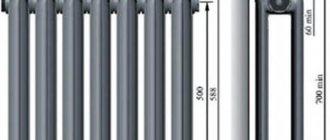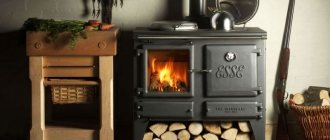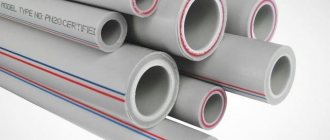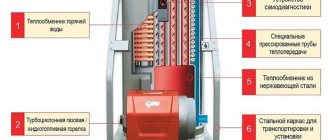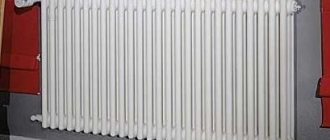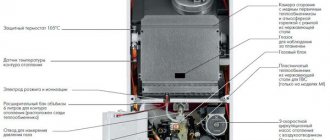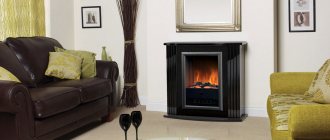Despite the emergence of innovative developments, the familiar heating system using radiators has not been forgotten: it is still just as popular. The reasons for this demand are its efficiency and reliability. However, in this case, an accurate calculation is required before installation. A lack of heat generated will lead to cold in the house in winter; its excess will require frequent ventilation and high heating costs. To avoid such consequences, it is better to find out in advance how many squares 1 radiator section is designed for. There are several ways to get the desired value - the right number of them. Some of them are approximate, others can be called quite accurate.
MS 140
The classic and most common radiator is installed in many apartments in our country, as well as in many countries of the post-Soviet space. Section width 140 mm, height (between supply pipes) 500 mm. Additional marking MC 140 – 500. The power of 1 section of this radiator is 175 W of thermal energy.
However, there are many variations of this radiator
MS 140 – 500 with fins (collector)
The most energy-efficient version of the MC 140 radiator. The thing is that additional cast-iron fins are installed between the sections, which also provide additional heating to the room. The power of such a radiator is 195 W of thermal energy (which is 20 W more than the classic MC 140). However, such radiators have a significant disadvantage: you need to monitor the frequency of these fins; if they become clogged (with dust, for example), then the thermal efficiency drops by 30 - 40 W!
MC 140 – 300
As the name implies, this radiator has a width of the same 140 mm, but a height of only 300 mm. This is a compact type of radiator. The power of one section is only 120 W of thermal energy.
How much does a section of a cast iron battery weigh: calculating the weight of the structure
To calculate a heating system, you need to take into account many different parameters. One of them is the weight of heating appliances. For example, you need to install a classic cast iron radiator, which consists of 4-10 sections. To calculate the mass of the entire heating system, you must first make a calculation regarding one cast-iron battery, which will ensure its installation reliability.
About cast iron batteries
The cast iron radiator belongs to the classics of the genre. It has been used for more than 100 years and not a single modern model has yet been able to completely displace it from the market. Cast iron radiators are in demand due to the characteristics of the material itself.
Important advantages of cast iron are:
- Corrosion resistance,
- Long service life,
- Undemanding to the quality of the coolant,
- Excellent heat transfer,
- Undemanding in use.
Everything cannot be so smooth, and two shortcomings still exist.
- One lies in the mass . How much does a cast iron battery section weigh? The weight of 1 section of a cast iron radiator is approximately 7.5 kg. Thanks to simple conclusions, we can come to the conclusion that a standard 7-section battery will weigh 52.5 kg. To ensure a comfortable temperature in the room, one section of the heating element is usually not enough. Based on these circumstances, in order to ensure the reliability of the design, it is necessary to think through ways to attach the radiator elements to the wall. Let's do the calculation using an example. The Soviet model MC 140, which is still on the market, has a considerable mass - 7.12 kg. The volume of one section is 1.5 liters of water, the total weight is 8.62 kg. The thermal power is approximately 170 W. How many sections are needed to heat a room of 20 m2? If it is necessary to heat a room of 20 m2, then 12 sections will be required, then the mass will be 85.4 kg, plus water - 103.4 kg.
- The second negative point of cast iron is its fragility . Therefore, in order to carry out the transfer of a product with a large mass and its fastening, it is necessary to carry out all manipulations with it as carefully as possible, preventing the slightest impacts in order to avoid microcracks invisible to the eye. Since during work with an inevitable increase in pressure in the heating network, the resulting cracks will begin to increase, which will end in radiator leaks.
Basic characteristics of a classic radiator
A standard cast iron battery consists of 4-10 separate sections. Its size depends on the choice of thermal conditions in the room and the architectural features of the house.
Despite the difficulties that arise when installing a heavy cast iron heating radiator, this is not considered the main problem. The main task is to correctly install the battery. To implement it, it is not enough to know only the mass of the product; the following points must be taken into account:
- Distance between axles. Standard models can have 350 or 500 mm. Batteries with a large height are characterized by proportional dimensions between the axes.
- Depth. Standard sizes 92, 99, 110 mm.
- Section width. The sizes are in a slightly larger range - 35 - 60 mm.
- Section volume. This is the amount of coolant that is necessary to completely fill the radiator element. The volume depends on the size of the section. Average values range from 1 to 4 liters.
New cast iron radiators
It is not uncommon now to see modern cast iron radiators, produced by both imported companies and our domestic ones. They look somewhat similar to aluminum radiators. The power of 1 section of such a radiator ranges from 150 to 220 W, much depends on the size of the radiator.
And that’s all, I think I gave you the layout of the usual cast iron radiators. Of course, the power may vary a little from manufacturer to manufacturer, but approximately the power remains within these limits.
By the way, you can read how to decorate a cast iron battery as “RETRO” , it turns out very beautiful and inexpensive
What types of radiators are there?
Before finding out how many squares 1 radiator section is designed for, you need to get acquainted with the types of these products, since the final result largely depends on their properties. The range now includes aluminum, bimetallic, steel and traditional cast iron batteries.
Aluminum
These batteries appeared recently, but their “young age” did not prevent them from immediately gaining popularity. New products are relatively inexpensive, they look modern and elegant. They also have no problems with heat transfer. The best models are able to withstand pressure of 15 atmospheres and higher with honor; high water temperatures (up to 100°) are also not scary for them.
The heat output of one section can reach 200 W. The list of advantages includes light weight, since 1 section of the radiator “tightens” a maximum of 2 kg, and its capacity is small - 500 ml, no more. There are two options available in stores - one-piece products that are designed for a certain power, and stacked batteries that allow you to change the number of sections.
“Newbies” are not without their shortcomings. Some models are very demanding on the quality of the coolant, as they are susceptible to oxygen corrosion. Non-removable structures may leak and cannot be repaired, so replacement will be required. The best option is products made using anodizing. The oxide film reliably protects them from corrosion.
Bimetallic
These modern radiators can be considered universal: in terms of reliability they compete with cast iron products, and in terms of heat transfer quality - with aluminum “heat exchangers”. The prefix "bi" means the presence of two metals - steel and aluminum. 1 section of the radiator consists of 2 horizontal collectors connected by a vertical channel.
The pipes are made of metal coated with a polymer coating. The outer shell is aluminum, which does not come into contact with the coolant, so it is not afraid of corrosion. Thanks to this combination, radiators have no weak points: they guarantee high strength, wear resistance and excellent thermal characteristics.
The batteries are not afraid of high temperatures and water hammer. These station wagons are suitable for both multi-apartment and private houses. The ideal condition for them is high pressure in the central system. If we talk about disadvantages, then the only disadvantage of any high-quality product is only one: it is a high price when compared with the cost of other competitors.
Steel
These structures have a low price, low weight, and are quite easy to install. Despite all the advantages, attractive appearance, variety of design solutions, steel batteries still could not become worthy rivals to devices made from other materials. The reason is their characteristics.
Thin walls heat up very quickly, but cool down just as quickly. With water hammer, a more serious problem is possible - the appearance of a leak. Another disadvantage is corrosion of those models that are not protected by a special coating. The service life of such products is depressing: manufacturers provide a small guarantee.
Steel radiators, as a rule, are not divided into sections; they are a solid structure. In this case, when choosing, they are guided by the passport specific thermal power, taking into account the footage of the room and its features. There are exceptions - tubular batteries, but they are not very practical: the number of sections can only be changed during production, to order.
Cast iron
Everyone has been familiar with these batteries since childhood, because such structures used to be installed everywhere. If you compare those old batteries with modern products, the difference in appearance is enormous, but the “hulks” served faithfully for more than one generation. 1 section of the radiator had good heat dissipation - about 160 W.
Now the range of cast iron batteries has expanded significantly. Some models are not only in no way inferior in beauty to their lighter and more elegant competitors, but sometimes even surpass them. The external transformation did not in any way affect the characteristics of the models. They also retain heat for a long time and have high heat output.
Correct installation allows you not to worry about water hammer and temperature changes. Thick cast iron perfectly resists corrosion and attacks from abrasive coolant particles, so it can be used in any heating system. Disadvantages - the relative fragility of the metal, the complexity of installation due to the massiveness of the products, heavy weight, requiring durable interior partitions.
Characteristics of heating radiators
Battery efficiency depends on the following factors:
- coolant supply temperature;
- thermal conductivity of the material;
- battery surface area;
The higher these indicators, the greater the thermal power of the devices.
Effective heat transfer of heating batteries depending on the method of installation and connection
The unit of measurement for heat transfer from a radiator is usually considered to be W/m*K; along with this, the format cal/hour is often indicated in the passport. Conversion factor from one unit of measurement to another: 1 W/m*K = 859.8 cal/hour.
Cast iron heating radiators
Depending on the materials of manufacture, cast iron, steel, aluminum and bimetallic radiators are distinguished. Each material has indicators for the following parameters:
- heat transfer of one section;
- working pressure;
- crimping pressure;
- containers of one section;
- the mass of one section.
Advice! We should not forget about the susceptibility of the battery material to corrosion. This is an important characteristic when purchasing a heater.
Steel batteries
Old steel radiators have a fairly high thermal output, but do not retain heat well. They cannot be disassembled or the number of sections increased. Radiators of this type are susceptible to corrosion.
Currently, panel radiators made of steel have begun to be produced, which are attractive due to their high heat output in a small size compared to sectional radiators. The panels have channels through which coolant circulates. The battery can consist of several panels; in addition, it can be equipped with corrugated plates that increase heat transfer.
Construction of steel panel radiators
The thermal power of steel panels is directly related to the dimensions of the battery, depending on the number of panels and plates (fins). The classification is carried out depending on the radiator fins. For example, type 33 is assigned to three-panel heaters with three plates. The range of battery types is from 33 to 10.
Independent calculation of the required heating radiators is associated with a large amount of routine work, so manufacturers began to accompany products with tables of characteristics, which were generated from records of test results. These data depend on the type of product, installation height, coolant temperature at the inlet and outlet, standard room temperature and many other characteristics.
Steel panel radiator
Classification of heating devices
Depending on the material used for manufacturing, heating radiators can be:
- steel;
- aluminum;
- bimetallic;
- cast iron
Each of these types of radiators has its own advantages and disadvantages, so it is necessary to study their technical characteristics in more detail.
Cast iron batteries - time-tested heating devices
The main advantages of these devices are high inertness and fairly good heat transfer. Cast iron batteries take a long time to heat up and are also able to release the accumulated heat for a long time. The heat output of cast iron radiators is 80-160 W per section.
These devices have many disadvantages, among which the most serious are:
- a large difference between the flow area of the risers and batteries, as a result of which the coolant moves slowly through the radiators, which leads to their rapid contamination;
- low resistance to water hammer, operating pressure 9 kg/cm2;
- heavy weight;
- requirement for regular care.
Aluminum radiators
Batteries made of aluminum alloys have a lot of advantages. They are attractive, do not require regular maintenance, and are not brittle, which makes them better resistant to water hammer than their cast iron counterparts. Working pressure varies depending on the model and can be from 12 to 16 kg/cm2. Another undeniable advantage of aluminum batteries is the flow area, which is less than or equal to the internal diameter of the risers. Thanks to this, the coolant moves inside the sections at high speed, which makes it almost impossible for dirt to accumulate inside the device.
Many people believe that a small cross-section of radiators leads to low heat transfer. This statement is incorrect, since the heat transfer of aluminum is higher than, for example, that of cast iron, and the small cross-section in the batteries is more than compensated by the area of the radiator fins. According to the table below, the heat output of aluminum radiators depends on the model and can range from 138 to 210 W.
But, despite all the advantages, most experts do not recommend them for installation in apartments, since aluminum batteries may not withstand sudden pressure surges when testing central heating. Another disadvantage of aluminum batteries is the rapid destruction of the material when other metals are used in conjunction with it. For example, connecting to radiator risers through brass or copper pipes can lead to oxidation of their inner surface.
Bimetallic heating devices
These batteries do not have the disadvantages of their cast iron and aluminum “competitors”. A design feature of such radiators is the presence of a steel core in the aluminum fins of the radiator. As a result of this “fusion”, the device can withstand colossal pressure of 16-100 kg/cm2.
Engineering calculations have shown that the heat dissipation of a bimetallic radiator is practically no different from that of an aluminum radiator, and can vary from 130 to 200 W.
The flow area of the device is, as a rule, smaller than that of risers, so bimetallic radiators are practically not contaminated.
Despite its many advantages, this product has a significant drawback - its high cost.
Steel radiators
Steel radiators are perfect for heating rooms powered by an autonomous heating system. However, such radiators are not the best choice for central heating as they may not withstand the pressure. They are quite light and resistant to corrosion, with high inertia and good heat transfer rates. Their flow area is most often smaller than that of standard risers, so they rarely become clogged.
Among the disadvantages are the rather low operating pressure of 6-8 kg/cm2 and resistance to water hammer, up to 13 kg/cm2. The heat transfer rate for steel batteries is 150 W per section.
The table shows the average heat transfer and operating pressure for heating radiators.
